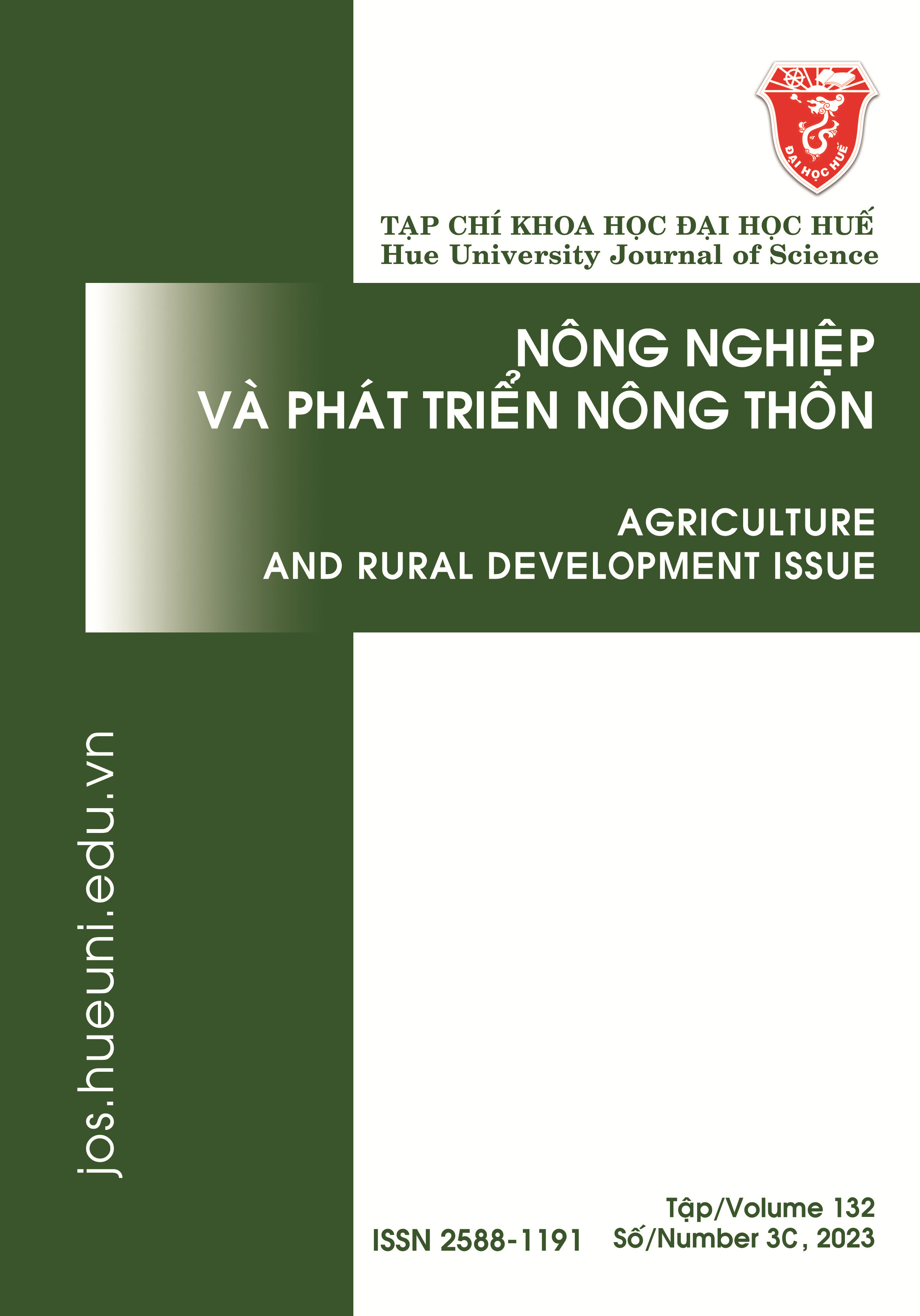Tóm tắt
Enzootic pneumonia is a highly contagious chronic respiratory disease in pigs caused by Mycoplasma hyopneumoniae (M. hyopneumoniae) worldwide. P46 of M. hyopneumoniae is considered one of the main surface antigen proteins. This study aims to successfully clone and express P46 of M. hyopneumoniae in Escherichia coli M15 cells. The gene encoding P46 of M. hyopneumoniae was isolated from lung samples of infected pigs raised in Thua Thien Hue province, Vietnam, and cloned into vector pGEM®-T Easy. The PCR product digested by KpnI and BamHI enzymes was cloned into the pQE30 and expressed in E. coli M15 cells. The results of sequencing show that the nucleotide sequence of the cloned gene encoding P46 antigen protein has a length of 456 bp, corresponding to 152 amino acid residues and 99.34% similarity to the polypeptide chain of recorded M. hyopneumoniae P46 protein in GenBank (accession number: AAZ53879.1). The results of sodium dodecyl sulfate-polyacrylamide gel (SDS-PAGE) analysis show that the molecular mass of the expressed protein is approximately 20 kDa, and anti-histag ELISA confirms that the expressed protein is the 6xHis-P46 recombinant protein.
Tài liệu tham khảo
- Austen, Y. C., Scott, R. F., Judy, F. F., Grant. D., Mukkur, T. K. S. (2006), Evaluation of the immunogencity of the P97R1 adhesion of Mycoplasma hyopneumoniae as a mucosal vaccine in mice, J. Med. Microbiol., 55, 923–929.
- Sheldrake, R. F., Gardner, I. A., Saunders, M. M., Romalis, L. F. (1991), Intraperitoneal vaccination of pigs to control Mycoplasma hyopneumoniae, Res. Vet. Sci, 51(3), 285–291, https://doi.org/10.1016/0034-5288(91)90079-4.
- Thacker, E. L., Thacker, B. J., Boettcher, T. B., Jayappa, H. (1998), Comparison of antibody prduction, lymphocyte stimulation and production induced by four commercial Mycoplasma hyopneumoniae bacterins, J. Swine Health Prod, 6(3), 107–112.
- Thacker, E. L., Halbur, P. G., Ross, R. F., Thnawongnuwech, R., Thacker, B. J. (1999), Mycoplasma hyopneumoniae potentiation of porcine reproductive and respiratory syndrome virusinduced pneumonia, J. Clin. Microbiol, 37(3), 620–625.
- Jang, E. J., Kim, T. J. (2007), In vitro expression of the 50 kDa and 30 kDa fragments of the P97 adhesin of Mycoplasma hyopneumoniae in Escherichia coli and their use for serodiagnosis, Can. J. Vet. Res., 71, 278–282.
- Calsamiglia, M., Pijoan, C., Trigo, A. (1999), Application of a nested polymerase chain reaction assay to detect Mycoplasma hyopneumoniae from nasal swabs, J. Vet. Diagn Invest., 11(3), 246–251, https://doi.org/10.1177/104063879901100307.
- Holst, S., Yeske, P., Pieters, M. (2015), Elimination of Mycoplasma hyopneumoniae from breed-to-wean farms: A review of current protocols with emphasis on herd closure and medication, J. Swine Health Prod., 23(6), 321–330.
- Maes, D., Segales, J., Meyns, T., Sibila, M., Pieters, M., Haesebrouck, F. (2007), Control of Mycoplasma hyopneumoniae infections in pigs, Vet. Microbiol, 126, 297–309, https://doi.org/10.1016/j.vetmic.2007.09.008.
- Thacker, E. L., Thacker, B. J., Kuhn, M., Hawkins, P. A., Waters, W.R. (2000), Evaluation of local and systemic immune responses induced by intramuscular injection of a mycoplasma hyopneumoniae bacteria to pigs, Am. J. Vet. Res., 61, 1384–1389.
- Futo, S., Seto, Y., Okada, M., Sato, S., Suzuki, T., Kawai, K., et al. (1995), Recombinant 46-kilodalton surface antigen (P46) of Mycoplasma hyopneumoniae expressed in Escherichia coli can be used for early specific diagnosis of Mycoplasmal pneumonia of swine by enzyme-linked immunosorbent assay, J. Bacteriol, 177, 1915–1917, https://doi.org/10.1128/jcm.33.3.680-683.1995.
- Galli, V., Simionatto, S., Marchioro, S. B., Fisch, A., Gomes, C. K., Conceicão, F. R., et al. (2012), Immunisation of mice with Mycoplasma hyopneumoniae antigens P37, P42, P46 and P95 delivered as recombinant subunit or DNA vaccines, Vaccine, 31(1), 135–140, http://dx.doi.org/10.1016/j.vaccine.2012.10.088.
- Simionatto, S., Silvana, B., Galli, V., Brum, B., Klein, S., Rebelatto, R., et al. (2012), Immunological characterization of Mycoplasma hyopneumoniae recombinant proteins. Comparative Immunology, Microbiology and Infectious Diseases, 35, 209–216. https://doi:10.1016/j.cimid.2012.01.007.
- Natasha, O., Sérgio, J., Charles, K. G., Caroline, R., Violetta, D. P., Thais, F. C., et al. (2017), A novel chimeric protein composed of recombinant Mycoplasma hyopneumoniae antigens as a vaccine candidate evaluated in mice, Vet. Microbiology, 201, 146–153, http://dx.doi.org/doi:10.1016/j.vetmic.2017.01.023.
- Virginio, V. G., Taylor, G., Jéssica, A. P., Desirée, C. S., Arnaldo, Z., Henrique, B. F. (2014), Immune responses elicited by Mycoplasma hyopneumoniae recombinant antigens and DNA constructs with potential for use in vaccination against porcine enzootic pneumonia, Vaccine, 32, 5832–5838, http://dx.doi.org/10.1016/j.vaccine.2014.08.008.
- Phung Thang Long, Le Quoc Viet, Le Viet Quan, Dong Huu Rin, Nguyen Xuan Hoa, Le Duc Thao, et al. (2019), Cloning and Optimizing the Culture Parameters for Expression of R1 and R2 Repeat Regions of P97 Adhesin from Mycoplasma hyopneumoniae in Escherichia coli., Adv. Anim. Vet. Sci., 7(12), 1067–1077, http://dx.doi.org/10.17582/journal.aavs/2019/7.12.1067.1075.
